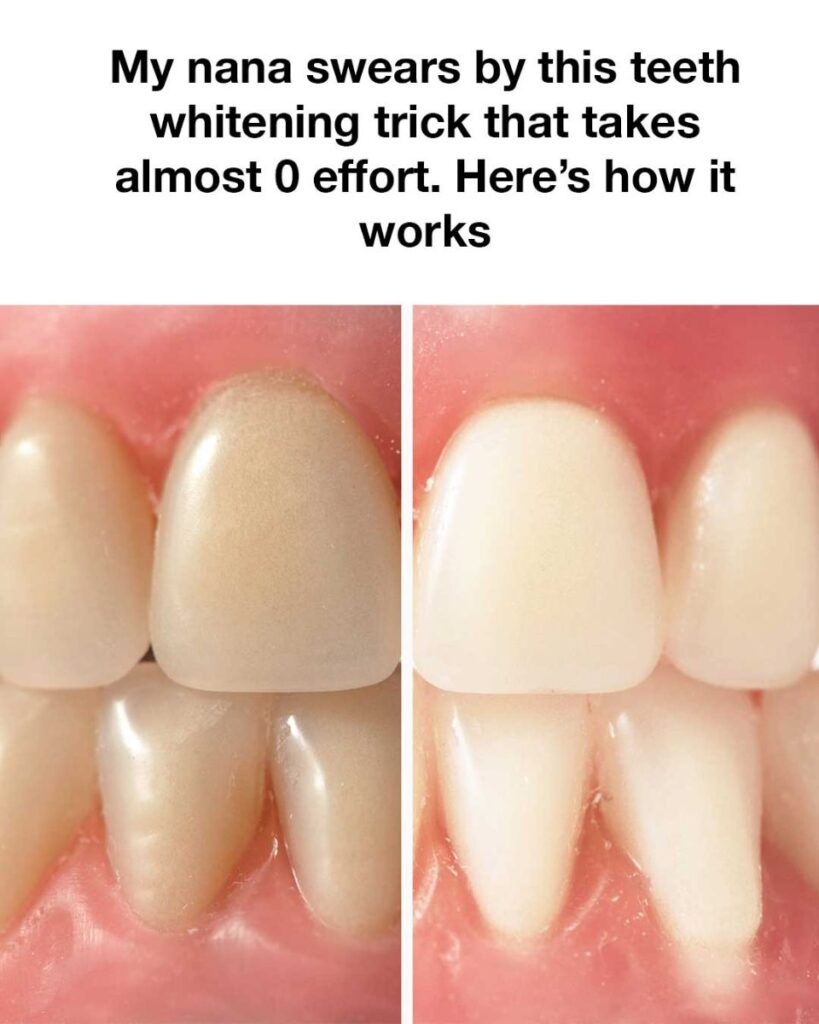
If there’s one thing my nana has always been known for, it’s her bright, beaming smile. At 80 years old, she has the kind of teeth that people spend hundreds of dollars trying to achieve at a dentist’s office or with expensive at-home kits. But what’s her secret? It turns out, my nana swears by a teeth-whitening trick that takes almost no effort at all. The best part? You likely already have everything you need at home.
In this article, I’ll reveal my nana’s go-to method for keeping her teeth sparkling white, explain how it works, and share a few tips on making the most out of this simple and effective routine.
The Secret Ingredient: Baking Soda
My nana’s teeth-whitening trick centers around one key ingredient: baking soda. You might have heard of baking soda being used for cleaning or deodorizing, but it’s also a fantastic and natural way to whiten teeth. Nana discovered this trick decades ago, long before the market was flooded with teeth-whitening products, and she’s stuck with it ever since.
Why Baking Soda?
Baking soda, or sodium bicarbonate, is a mildly abrasive substance. This means it’s excellent at scrubbing away surface stains from your teeth caused by things like coffee, tea, red wine, or tobacco. The gentle abrasiveness of baking soda helps break up particles on the surface of the enamel without being too harsh or damaging to the teeth.
Moreover, baking soda is alkaline, which can help balance the pH level in your mouth and reduce acidity. This property helps protect tooth enamel from erosion caused by acidic foods and drinks. And to top it all off, baking soda has antibacterial properties that help in reducing the bacteria in your mouth, leading to better oral health overall.
How to Use Baking Soda for Teeth Whitening
Using baking soda for teeth whitening is incredibly simple and requires almost no extra effort. Here’s how you can incorporate my nana’s method into your daily routine:
Prepare a Baking Soda Paste: Mix a small amount of baking soda with water to create a thick paste. You can use about a half teaspoon of baking soda and add just enough water to form a paste-like consistency.
Brush Your Teeth: After you’ve prepared the paste, apply it to your toothbrush. Brush your teeth as you normally would, using gentle, circular motions. It’s important not to be too aggressive, as over-brushing with baking soda can be abrasive to the enamel if done excessively.
Rinse Thoroughly: After brushing, rinse your mouth thoroughly with water to remove any remaining baking soda residue.
Repeat Regularly, but Not Excessively: For best results, my nana suggests doing this a few times a week. It’s essential not to overdo it, as too much scrubbing can wear down the enamel over time. A good rule of thumb is to use baking soda two to three times a week.
Why This Trick Works
My nana’s trick is effective because it removes surface stains without the use of harsh chemicals. Many commercial teeth-whitening products contain hydrogen peroxide or carbamide peroxide, which can sometimes cause sensitivity or gum irritation. Baking soda, on the other hand, is a natural and gentle alternative that works gradually to whiten teeth without causing discomfort.
Here’s why this trick has stood the test of time:
Cost-Effective: Baking soda is inexpensive and widely available, making it a budget-friendly option for anyone looking to whiten their teeth without breaking the bank.
Minimal Effort: You don’t need to set aside time for this method; simply replace your regular toothpaste with the baking soda paste a few times a week.
Natural and Safe: With no harsh chemicals, this method is gentle on your teeth and gums, reducing the risk of sensitivity and irritation.
Dual Benefits: Besides whitening, baking soda helps in maintaining overall oral hygiene by reducing bacteria and neutralizing acids that contribute to tooth decay.
Tips for Maximizing Results
While my nana’s baking soda method is a fantastic, low-effort way to whiten your teeth, there are a few additional tips to help you get the best results:
Combine with Regular Oral Hygiene: Make sure to continue brushing twice daily with fluoride toothpaste and flossing regularly. Baking soda should complement, not replace, your usual oral care routine.
Avoid Stain-Causing Foods and Drinks: Limiting your intake of coffee, tea, red wine, and sugary drinks can help maintain your results and prevent new stains from forming.
Stay Hydrated: Drinking plenty of water throughout the day can help wash away food particles and bacteria, keeping your mouth cleaner and reducing the risk of stains.
Use a Soft-Bristled Toothbrush: Since baking soda is mildly abrasive, using a soft-bristled toothbrush will help protect your enamel from excessive wear.
Be Patient: Unlike some commercial whitening treatments that promise instant results, baking soda works more gradually. Give it time, and you’ll start to see a noticeable difference in the brightness of your smile.
A Word of Caution
While